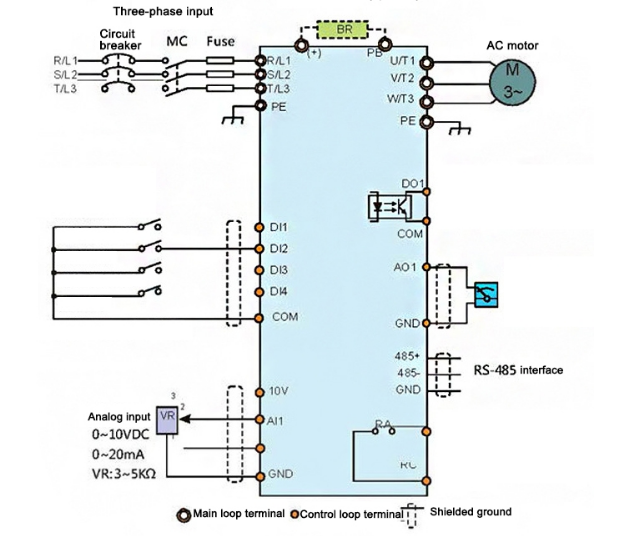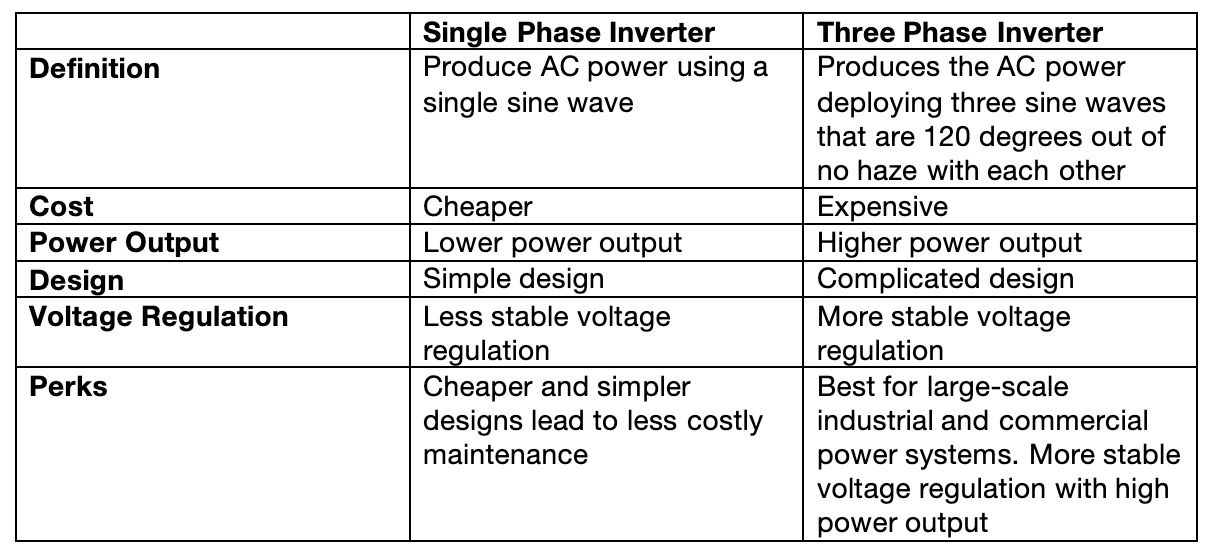
Single Vs. Three Phase Inverter
Inverters are the crucial components of the electricity storage system that convert DC power into AC power for myriad applications. Among these, single-phase and three-phase inverters are commonly deployed, each offering the same purposes but with notable differences that make them more suited to specific applications.
In this article, we compare single and 3-phase inverters. But before digging into a single Vs three-phase inverter, it’s crucial to know what type of inverter they are.
What are Single-Phase Inverters?
Single-phase inverters majorly operate in residential and small-level commercial settings that convert the DC power to AC, deploying a single sine wave, making the voltage oscillate both negatively and positively about 120 or 240 times in a second. Then, this sine wave inverter's positive and negative variations generate a waveform-like sine curve.
Simplicity and affordability are the main perks of choosing a single-phase inverter. Their reliance on a single sine wave simplifies their electronic needs, making them affordable to produce. However, the simple design of this inverter comes with disadvantages, like they provide lower power output and low stable voltage regulation as compared to three-phase inverters. This makes them less beneficial for large-scale and high-power energy needs.
Generally, single-phase inverters are used in small devices and residential solar power systems for other applications with minimum power requirements. They are also widespread in regions with unstable or interrupted power grids, as they can be connected to the battery pack system.
What is a Three-Phase Inverter?
Three-phase inverters produce AC power by deploying three sine waves, each phase transformed by 120 degrees. Such a configuration enables four oscillations between positive and negative 208, 240, or 480 times in a second, allowing higher power output, more stable voltage regulation, and enhanced efficiency over single-phase inverters.
However, it also indicates that there are more complex and expensive inverters to convert energy. A notable perk of three-phase inverters is their capacity for high power output, making them the best for large-scale commercial, electric vehicle, industrial power systems, and high power requirements.
Furthermore, three-phase inverters are normally more expensive than single-phase inverters and have more complex electronics. This complexity can complicate the maintenance and installation of the system.
Single Vs. Three Phase Inverter
Here, we provide a table for an instant overview of single inverter Vs three-phase inverter;
Now let’s discover the difference in details;
Efficiency
Single-phase inverters are efficient for low-power applications. They may experience slightly lower efficiency at higher power levels. However, efficiency can be affected by multiple factors, such as the design of the inverter, the load it is driving, and the overall power system.
Three-phase inverters generally provide higher efficiency, especially at higher power levels. The balanced power delivery and lower transmission losses in a three-phase system contribute to overall optimized efficiency, making three-phase inverters the best choice for industrial applications with larger power requirements.
Power Stability
Single-phase inverters may experience power fluctuation and voltage imbalances, specifically in larger systems or under varying loads. Single-phase power delivery can result in lower stable power output compared to three-phase systems.
Three-phase inverters provide better power stability due to the balanced and consistent power supply of the three phases. The three-phase configuration assists with the lowest voltage fluctuations and ensures a more persistent power supply, which is highly important for the stable working of industrial machinery and other necessary equipment.
Voltage and Current
A single-phase inverter produces waveforms of voltage and current by establishing a single peak and zero crossing per cycle. This indicates that the power supply fluctuates between maximum and minimum values in a cyclic pattern. In terms of voltage, there is a single sinusoidal waveform, which may result in a less consistent power supply.
A three-phase inverter generates three sinusoidal voltage and current waveforms, each offset by 120 degrees. This configuration provides a smoother and more continuous power supply. The overlapping of three phases contributes to a more efficient and balanced deployment of electrical energy.
Motor Types
A single-phase inverter typically deploys single-phase motors, which are commonly used in small machinery, residential devices, and specific commercial applications. These motors are characterized by their cost-effectiveness and simplicity, making them ideal for less demanding tasks.
On the other hand, three-phase inverters are designed with three-phase motors, which are best for industrial and commercial settings. These motors are known for their reliability, high efficiency, and capability to handle high-power loads. They are commonly found in industrial machinery like pump compressors or heavy-duty equipment.
Damage Tolerance
A single-phase inverter system may be more prone to voltage sags and power interruptions. In the event of any disturbance or damage, the damage tolerance of a single-phase inverter may be restricted, and the impact on integrated equipment can be more pronounced.
Three-phase inverters provide better damage tolerance. The redundancy offered by this type of inverter maximizes the system’s resilience against faults or damage. In industrial or commercial environments, where constant operation is important, three-phase systems can better withstand faults and tolerate them, ensuring more reliable performance.
Bottom Line
We sum up single-phase inverters versus three-phase inverters by concluding that three-phase inverters are more efficient, reliable, Stable, and less prone to damage and faults. These inverters are undoubtedly more expensive and complex than single-phase inverters, but their long-term use and advantages are totally worth the money. Further, consider your energy needs before choosing the one for you.
If you need any help, you can contact Innotinum, as they offer cutting-edge technology for residential energy storage solutions. They can also help you choose the best solution for your home. So contact them right now and know what is best for your residential clean energy needs.


